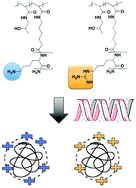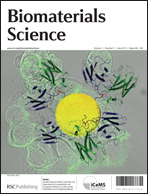Comparative study of guanidine-based and lysine-based brush copolymers for plasmid delivery†
Abstract
Polyethylenimine (PEI), one of the most frequently used polycations for non-viral nucleic acid delivery, exhibits good transfection efficiency to cultured cells but generally has to be used in restricted concentration ranges due to high cytotoxicity. We recently reported a family of HPMA-co-oligolysine brush copolymers that show nucleic acid delivery efficiencies approaching that of PEI. Guanidine-containing polymers have been reported in some systems to be more effective at cellular delivery of cargo than their primary-amine analogs. The goal of this work is to investigate the effect of guanidinylation on gene transfer ability of HPMA-co-oligolysine copolymers. Several parameters were evaluated: arginine versus homoarginine monomers, oligopeptide length, and charge density within the peptide. Using reversible addition-fragmentation chain transfer (RAFT) polymerization, a series of six copolymers were synthesized containing the cationic peptides K10, R10, K5, and (GK)5. Lysine-containing copolymers were functionalized with guanidine by reaction with O-methylisourea to generate an additional five homoarginine-based copolymers. All eleven copolymers readily condensed into small polyplexes (<250 nm) and remained stable in physiological salt conditions. The best performing copolymers provided more efficient gene transfection with less associated cytotoxicity than PEI. Reducing the number of charge centers (from 10 to 5) further reduced toxicity while retaining comparable transfection efficiency to PEI.

- This article is part of the themed collection: Biomaterials Science Lectureship Winners

 Please wait while we load your content...
Please wait while we load your content...